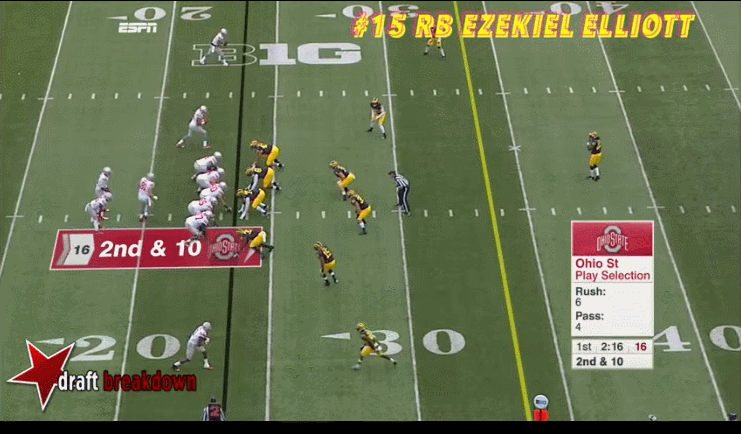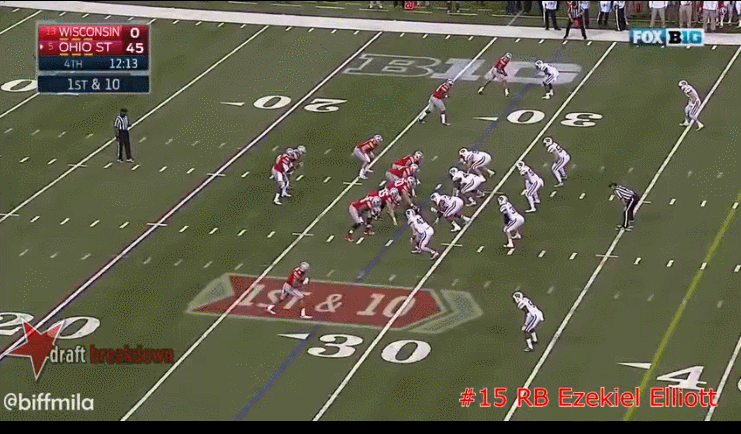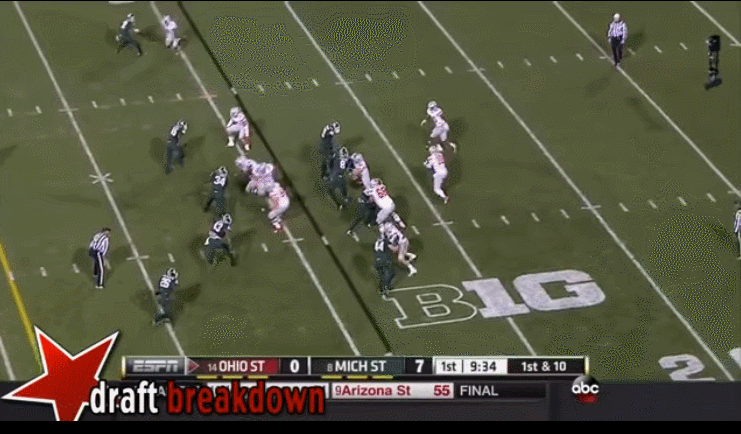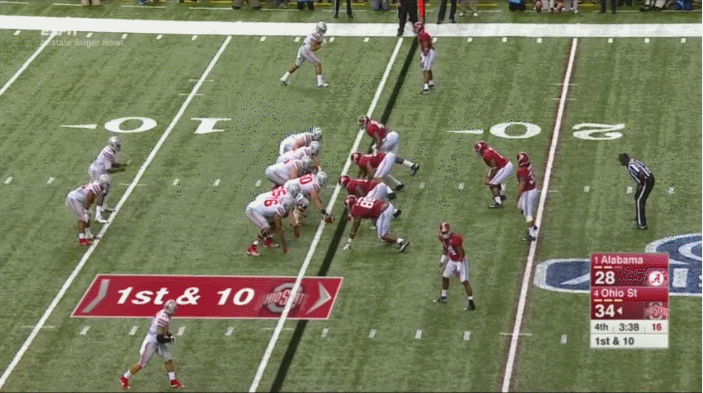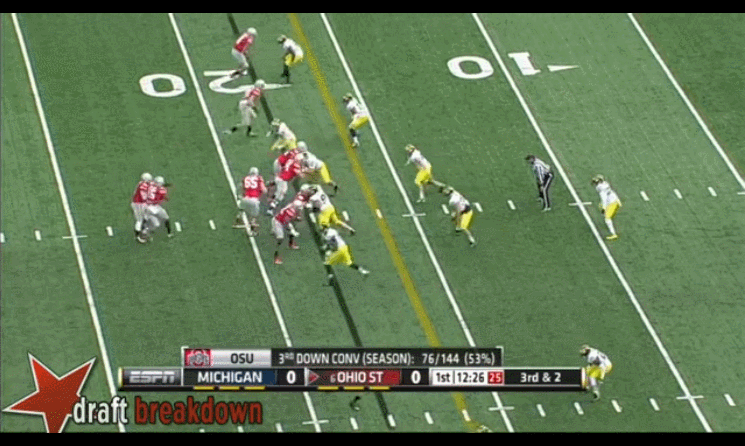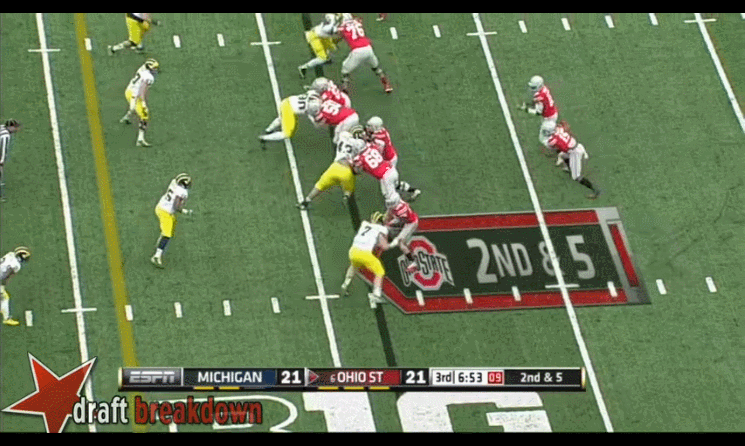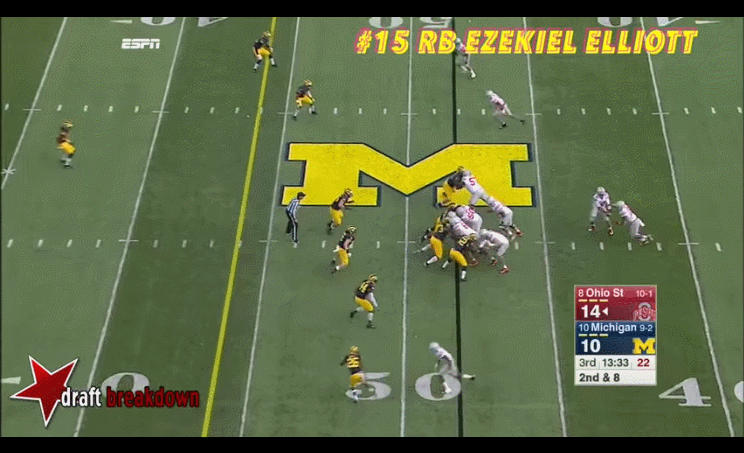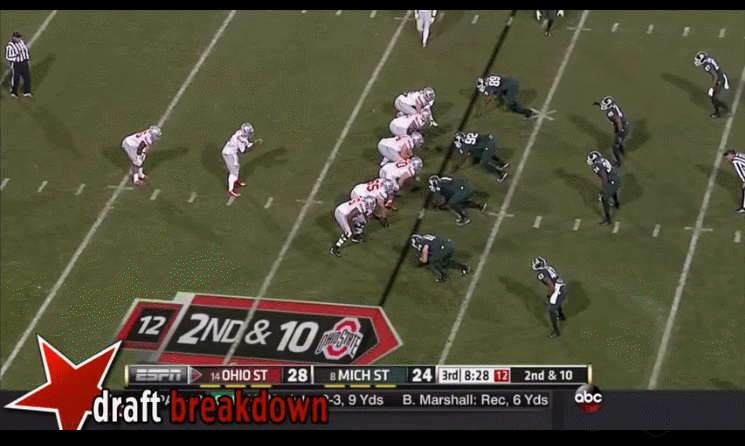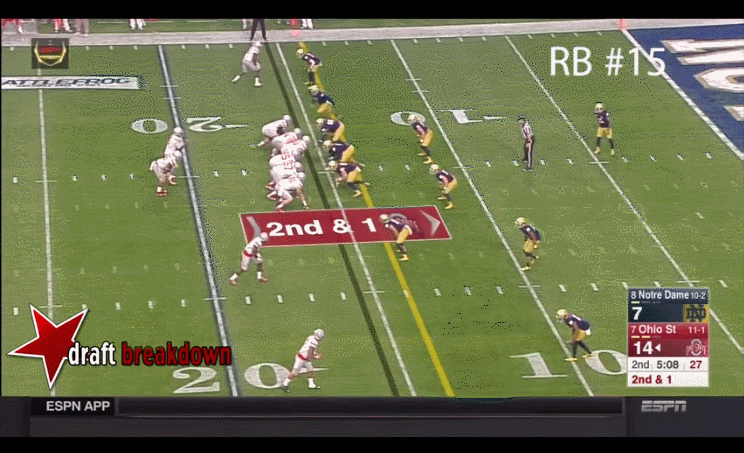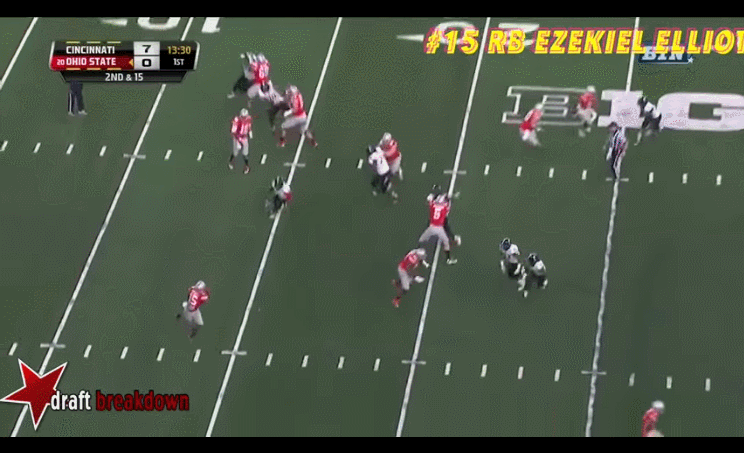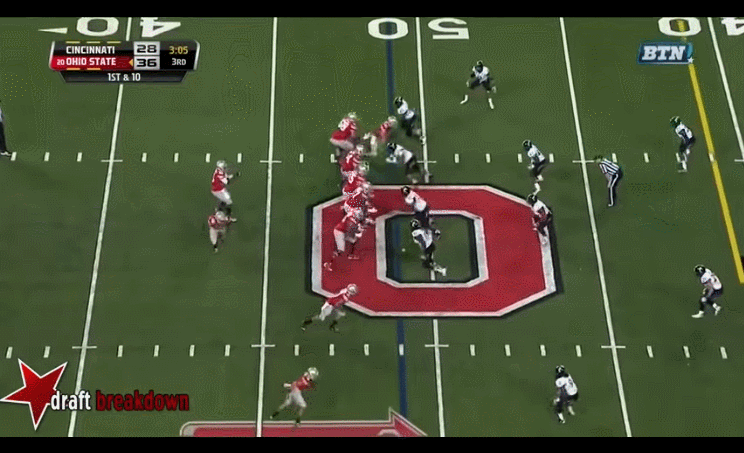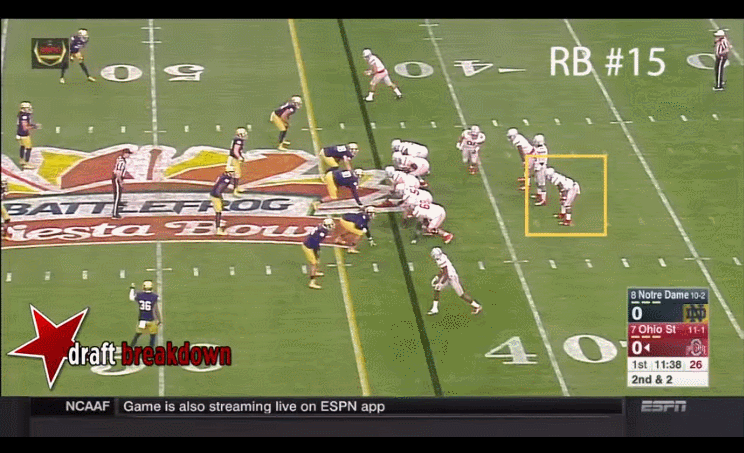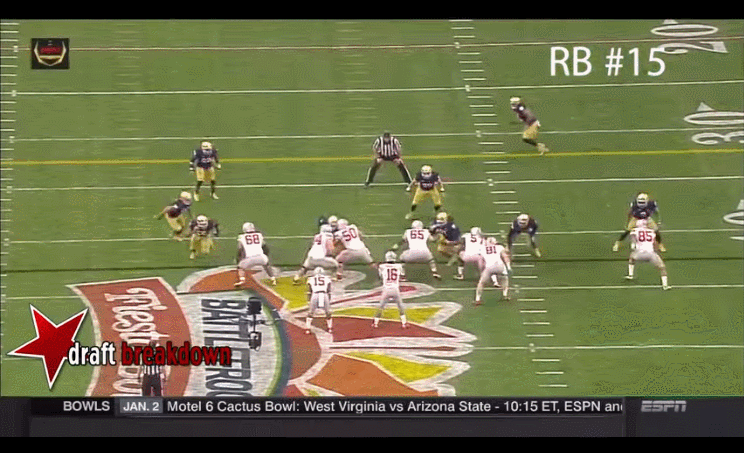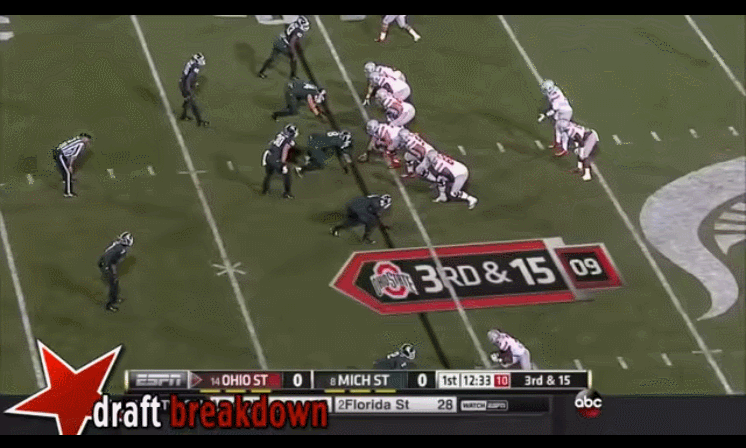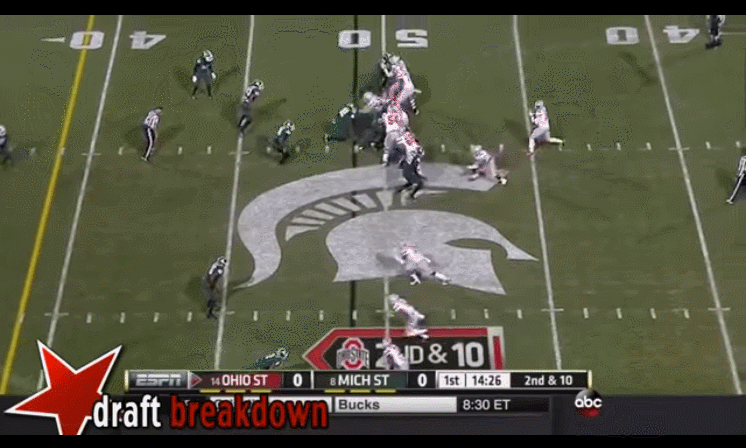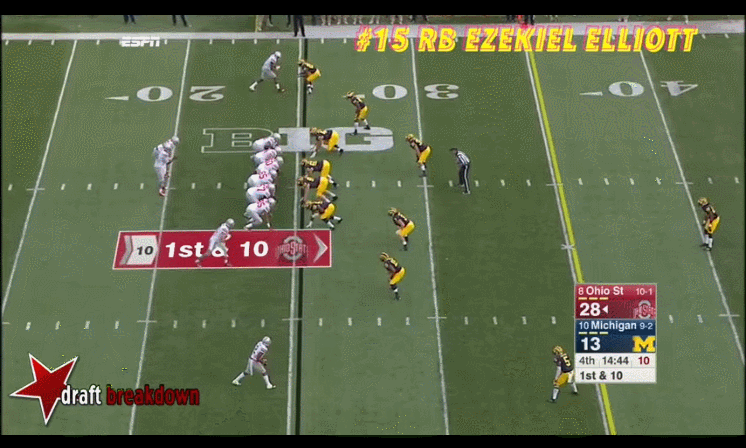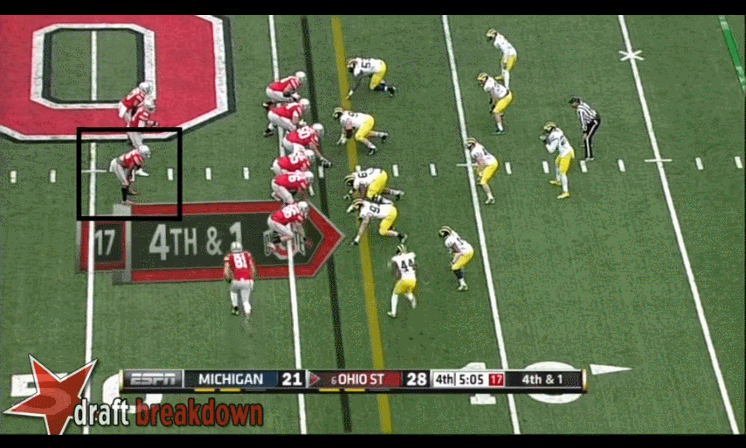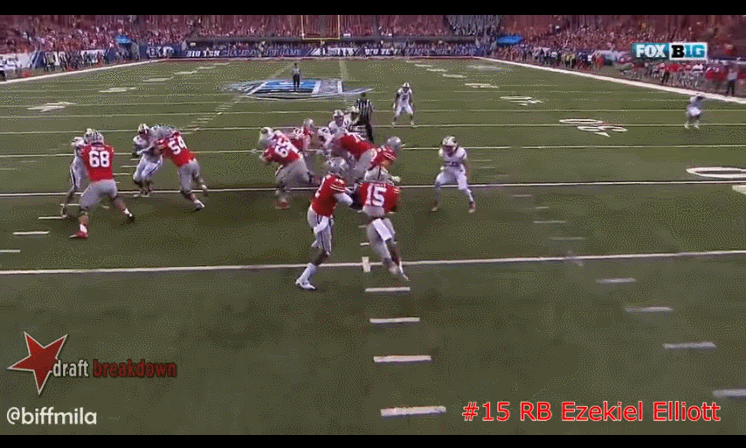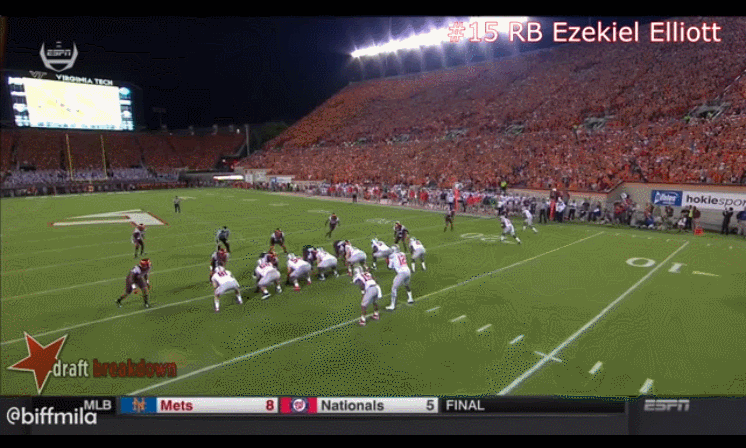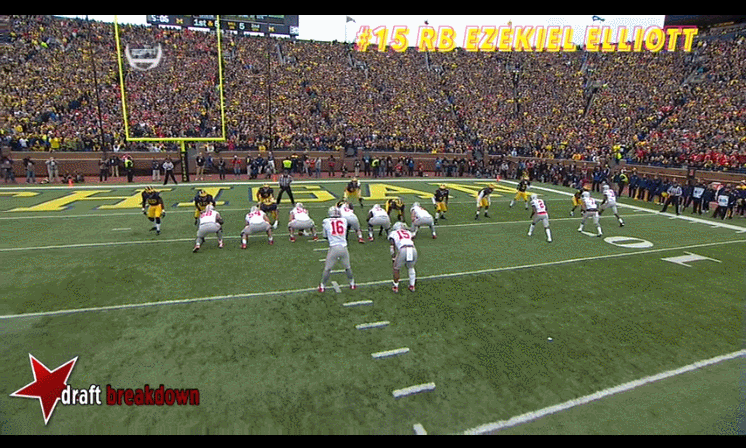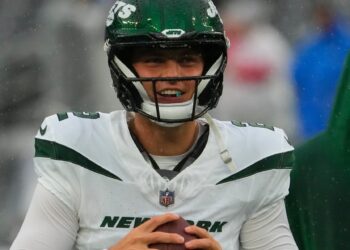Draft Featured Editorials Home Slider
Ezekiel Elliot- Scouting Report
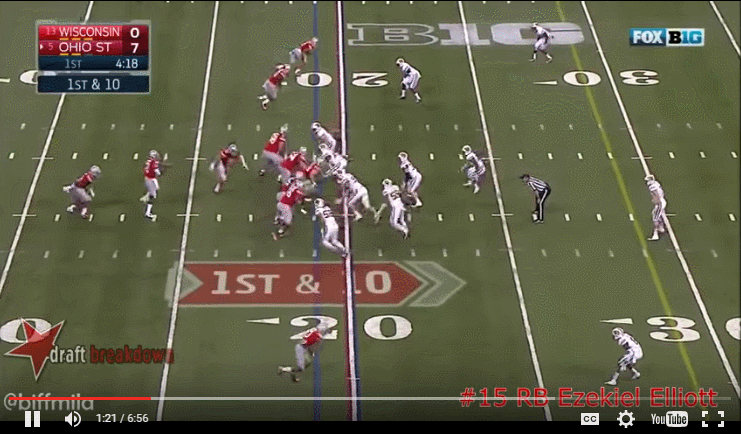
Welcome to the 2016 NFL draft scouting series at Jet Nation. We’ll feature many prospects that the Jets’ front office will be scouting in the weeks to come. Thanks to the folks at Draft Breakdown for compiling these videos. It’s a very good website to watch tape on prospects. Unfortunately, these are mostly media tapes, and not the All-22 tapes.
The first one with a scouting report is Ohio State running back Ezekiel Elliot, a popular mock draft pick for the Jets.
Scouting report:
Positives:
Speed:
1)
Elliot shows off very good speed on the football field, especially for a bruising back, and can consistently run away from linebackers in the open field. The first example is from the most recent Michigan game, where Elliot runs away from the safety and gets chased down well down the field. You will notice that No. 25 is trying to chase down Elliot, but doesn’t make up much ground. No. 25 is Dymonte Thomas on the Wolverines roster, and while there is no concrete 40-yard time, he’s expected to run right between a 4.4 and 4.5. Michigan had the 16th best rushing defense in the country, holding opposing teams to an average of 122 yards rushing per game, but Elliot burned them for 214 yards. The speed is on display when he bursts into the second tier and creates separation.
2)
The second example is from his sophomore year against Wisconsin (Jets’ fans can recall highlights from this game, as it was the game Devin Smith made 3 touchdowns) where he burns them up the middle. The Badgers are caught in a single high safety with the second safety mirroring the QB in this case. Once Elliot hits the hole and has open field ahead of him, no one was catching him. He again displays very good speed, and notice how none of the defenders are making up any ground on him as he runs to the end zone.
3)
The third example comes from the same game as the second example. The game is a lopsided win at this point, as you can see from the scoreboard. Elliot runs up the middle, and runs away from the linebackers again, and is running a step ahead of the safety Lubern Figaro (#31) when he gets pushed out of bounds. Figaro reportedly ran the 40-yard dash in the 4.5 range in high school. However, what is more impressive about this play is that Elliot makes the dash with only one shoe, as he lost the other show when the linebacker dove at his feet.
4)
The fourth example is from a game against Michigan State in his sophomore year as well. This is a simple read option play, which the DE (Calhoun) recognizes pretty early, but Elliot outruns him to the edge and accelerates past him for the first down. This is a good example of Elliot having lateral speed to get to the edge, turn the corner and get down field.
5)
The fifth example is one most people have seen before, one his best runs from the game against Alabama in the college playoff game. Alabama that year allowed 88 yards per game rushing, while Elliot notched 85 yards alone on this run. The play is simple, one cut up field, and Elliot explodes through the hole for the TD.
Power:
1)
The first example in power is very similar to a Chris Ivory run for the Jets in that he powers through the first defender. Michigan was 15th in the country against the run in Elliot’s sophomore year, and Elliot plowed through them on this play. While it is not a TD, it’s impressive how Elliot withstood two hits, kept his balance, and moved forward.
2)
The second example is also from the same game, where he just powers through the middle and wills himself to the first down. It takes about 5 Wolverines for Elliot to be brought down after he crosses the first down marker. This is one of the reasons why his speed is special because he combines it with very good power.
3)
The third example is from this year’s Michigan game, where he powers through the middle and breaks a tackle to get to the second level. The is a play that should be stopped for about 4 yards, but he turns it into a double digit gain. The linebacker has a straight shot on Elliot and he still breaks the tackle.
4)
The fourth example is from the Michigan State game from last year, where he drags the safety behind him for 5 yards down the field. If current Jet Devin Smith makes a block on his man, this might have been a TD.
5)
The fifth example is from the game against Notre Dame. The Fighting Irish didn’t have a great rush defense, and Elliot plows through the middle here shedding defenders. He comes close to scoring a TD, and it takes two defenders to bring him down.
Receiving:
1)
The first example of Elliot is from the Cincinnati game, where he makes a nice catch, turns upfield and gains a good amount of yardage. Notice how he naturally catches the ball while still on the run. He does not turn his whole body towards the QB to make that catch, instead turning his upper body to catch the ball, allowing him to retain momentum.
2)
The second example is also from the Cincy game, where he again makes a nice catch and gains yardage. The ball is a bit off, but he makes the adjustment, and fights off the defender to gain the first down.
Blocking:
1)
The first example is from the Notre Dame game, where he acts as the lead blocker for Braxton Miller. He completely takes No. 17 James Onwualu out of the play, opening up major space for Miller to run through. Many scouting reports have him as a very good blocker, although at times, he does rely on taking out the legs of defenders.
2)
The second example also comes from the same game, where Elliot picks up the blitz (interestingly enough same LB) and stand him up, allowing the play to develop. Notice how he also pushes him away from the play.
3)
The third example is from the Michigan State game, where he comes across the formation to pick up the blitz from the other side. This allows Devin Smith to wiggle free.
4)
The fourth example is also from the Michigan State game to emphasize his weakness when he has a tendency to go for the legs. On this play, the DE (Calhoun) all but steps over him, and breaks down the play.
Negatives:
The System:
1)
The System is probably one of the biggest negatives when it comes to Elliot. The first example is a play that you have already seen. The Badgers are in a single safety look, but look at where the safety is going at the start of the play. One of the most explosive RBs in the country is on the field, and the entire defense seems to shift towards where the QB is going towards, on the outside. It’s one of the downfalls of evaluating someone playing in a spread read option system. The defense has to account for the QB to be running as well, alas can’t commit as much towards the RB.
2)
The second example is from the Michigan game this year. Notice the somewhat delayed reaction of the middle linebacker at the exchange time. The play doesn’t go for big yards, but on a team that doesn’t feature a mobile QB, the defense would be more committed to stopping the RB.
3)
The third example is from the Michigan game last year. This is a 4th and 1 play, so the RB should be a main focus. However, Ohio State presents 3 options for the Wolverines to worry about in the back field and notice where the defense went. They vacated the middle, following the QB instead of possibly the top RB in this year’s class.
The Team:
1)
Ohio State is by far and away the most talented team in the Big10, and this allows for a significant advantage in talent in the trenches. The first example is again, the play from Wisconsin, but a different angle. Look at the hole created by the line. This can be called the Trent Richardson effect, where the offensive line is so talented that it’s hard for the RB to screw it up. Elliot takes advantage of the hole and makes a huge play, but it still leaves you to wonder about how much of an advantage Ohio State’s talent upfront provided for the RB.
2)
The second example is from the Virginia Tech game, where Elliot faces a stacked box. This usually means a power run, but Ohio State’s line opens up a massive hole right up the middle. Elliot runs up the middle, breaks a diving arm tackle, and is home free for the long TD.
3)
The third example is from the Michigan game this year, where on first and goal, Elliot has enough to space in the middle to deal with just an arm block. The offensive linemen make great blocks, and the only one who has a remote shot at Elliot is trying to disengage from a block.
Why the Jets should take Ezekiel Elliot:
- He demonstrates excellent speed and power combination that is rare in today’s game. He has breakaway speed, while also showing that he can power through the middle.
- The Jets will have a hole at RB, presumably after they let Chris Ivory walk in the off-season.
- He demonstrates a very advanced feel for picking up blitzes, and can engage blitzers instead of just bumping into them.
- He is a decent receiving ability, albeit he wasn’t utilized as a receiver when facing tougher defenses.
- He’s a true 3 down back that doesn’t have to get off the field.
- He’s dominated a major conference.
- He’s performed admirable on the biggest stages.
- Elliot would solve the issue at RB for years, helping add another element to a team that has weapons at WR.
- He is a good blocker, which helps out QB scrambles.
- Chan Gailey’s system uses zone blocking, and so does Ohio State, so there is familiarity in the blocking scheme.
- Todd Gurley was dominant as a RB with the Rams this year as a rookie.
- Gailey’s blocking system prefers a one cut RB, that can see a hole and cut up field. Elliot is exactly that.
Why the Jets should pass on Ezekiel Elliot:
- The Trent Richardson Effect: How much did Elliot benefit from the talented line at Ohio State?
- Melvin Gordon Effect: Gordon terrorized the same conference last year, got picked in the first round, and ended up with very pedestrian numbers with the Chargers.
- Opportunity Cost: RBs have been devalued. What other player do you give up on in the first round for Elliot when good RBs can be consistently found later in the draft? Such examples as Thomas Rawls and David Johnson from last year’s draft.
- While he has shown good receiving skills, he was very quiet in that aspect against tough defenses. He picked up most receiving yards against low ranked defenses.
- There are numerous plays where he just runs into the pile for 1 or 2 yards. He lacks the quick agility to make people miss consistently in the backfield. He’s a great one cut runner, but if that lane isn’t open for him to cut into, he has trouble improvising.
In the end, the decision isn’t easy, and if Elliot does end up being available at 20, the Jets will be in a very interesting position. Elliot displays elite skills in power, speed, and blocking. His receiving skills need to be refined a bit, but he shows promise. As a prospect, he has pretty much succeeded at every stage and shown skills that are impressive. The major decision comes down to if the Jets can afford to spend a pick on a RB when they need a QB or possibly a LB.
Videos
Justin Fields Every Throw From Every Start 2024 via JetNation.com

